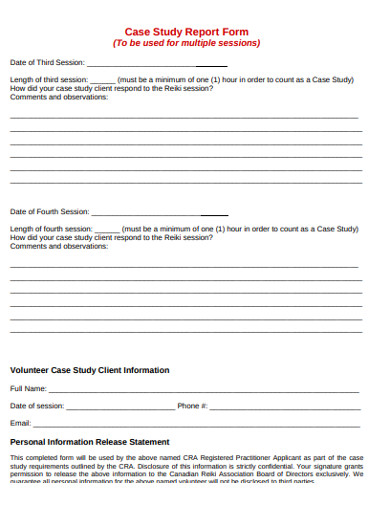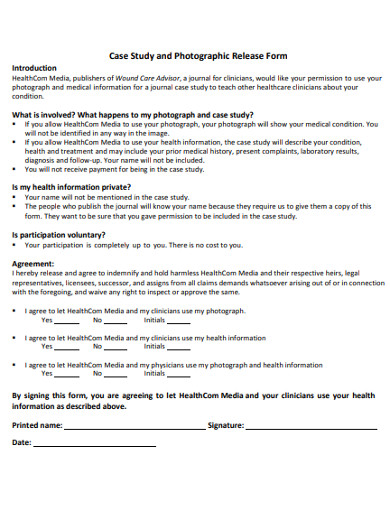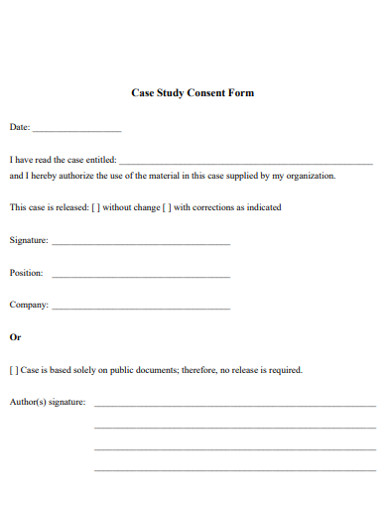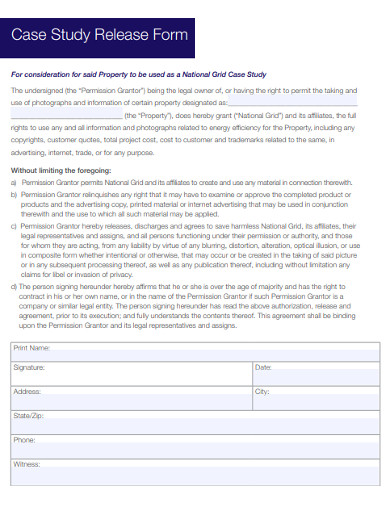5+ Case Study Release Form Examples to Download
By focusing on the quantum world of a universe, we gain a better grasp of how the latter behaves. Aside from an immersive take into a complex subject, case studies open new research directions. That is why they are a valuable academic resource. By signing case study release forms, we, as authors, consent to dispensing our studies to help build our understanding in a variety of subjects. A release form, therefore, is a key to a treasure chest of information.
Case study release forms are a more formal permission letter bearing the author’s consent to using his or her research. The author can prepare the form and send it to the people requesting access to the document for whatever business they may have. The latter can also make the release form and have themselves and the author as signatories.
You can also give these forms to the subjects of your case study after they have decided to participate in the research. The form indicates the kind of information that the volunteers are asked to supply. It also provides the participants with options on the disclosure of identifiable data.
Form Format
The details that you include in the form and its overall structure hinges on your role, grantor or requestee, in the transaction. When you are the researcher, you add the statement of purpose in the document. The statement is a rationale and intention for why you prepared the case report or study. You have to include how you expect the requestee to use your material and disclose its content.
When the requestee, here known as any entity seeking access to a case study, deems it appropriate to prepare the case study’s release form, he or she should establish his or her identity and the study’s ownership in the form. The document shall bear the reason for the interest in the research, along with the intended use. Some forms contain a list of acts on information use that the author can approve or reject.
Case study release forms are also useful as a written declaration of consent from the research participants with regards to how their data shall be used and disclosed by the author and the entity requesting.
Shield Your Rights
There have been legal troubles that arose from misuse or unconsented use of research material. The misconduct has caused the offenders their reputations and careers, even after a decade since committing the act. Some of the cases have been raised in judicial courts. Even though parties signed agreements indicating the agreed use of material, troubles stirred when the limits and boundaries were overstepped.
It is important to exercise caution and legality when handling even nontangible materials, such as intellectual property. It is not sufficient to just prepare and sign release forms, and any formal document in general. These are written and affirmed records pertaining to the treatment of sensitive and private data or original work. Once signed, you are accountable for whatever consequences your signature in that document merits.
5+ Case Study Release Form Examples
Don’t forget to include the crucial details in your case study release forms. Check out the following samples that show what kind of release information should go into the document.
1. Case Study Release Report Form Example
2. Sample Case Study Release Form Example
3. Case Study and Photographic Release Form Example
4. Case Study Consent Release Form Example
5. Case Study Placement Organization Form Example
6. Standard Case Studies Release Form Example
Writing Your Release Form
Remember that whatever is written in the release document may be used for or against you in the future, in a worst-case scenario. Therefore, you need to draft a release form that will shield you from repercussions that arise from not specifying the granted rights to the property or a shabby contract that removes accountability from an offending party.
1. Know Your Rights
Ask your attorney for advice regarding intellectual property rights. Whether you are the grantor or the requestee, you must know the power accorded to you by law in this case. This is so that you won’t be taken advantage of, and you can save yourself from legal trouble. If that isn’t an option, you can look up different release information form templates. Cross-reference the documents with each other, so you will know what you need to put in your document.
2. Cite Parties and Material
Write the information about the case study and the parties in the agreement completely. Case study details include the title of the study and its description, when possible. In an agreement, you should identify who are the entities which asked for and granted permission and their roles over the specified work. When signing the release form in the presence of both parties is not possible, you can send the file electronically. In the templates, the spaces for identifying the parties and the material in question are usually blank.
3. Specify Terms and Conditions
As the researcher, what are the rights that you will grant the person or organization requesting access? As the requestee, what are the actions that you need authorization from the author for? You have to understand the kind and extent of power that you can give or are given over the case study. You also have to specify and spell out this power and duration of its validity in the document. Good communication of obligations between both parties is vital. Come a legal dispute, this portion may decide the case for you.
4. Draft Safety Clause
It is also wise to indicate a course of action in the case of a breach in the agreement. As the author, you have the full right to your case study. When you grant the requestee access to your document, you can give them full or partial rights to the material. Unlike when you sign a waiver, you can limit or revoke access. Should you find that the grant you gave was exploited, you can withdraw the authorization. Also include in the document the fees or royalties that come with permission for access.








